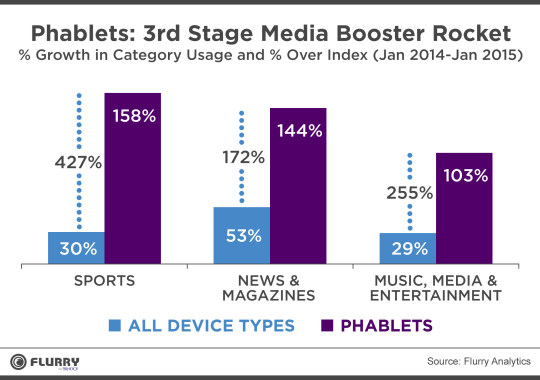March 5, 2015 | Simon Khalaf
Since Apple launched the App Store in July 2008, media consumption on smart devices and in apps has skyrocketed - it has even surpassed the web and TV in total time spent. First, smartphones (led by the iPhone) started taking share from online media consumption on the web. Then the tablet (led by the iPad) accelerated that trend. In fact, in January 2010, we labeled the iPad as the “second-stage media booster rocket.” It helped its predecessor the iPhone shift media consumption (and ad dollars) from TV and desktop to mobile. As if that shift weren’t fast enough, this year we have seen a new type of device accelerate this trend: the phablet.
Phablets Lead the Mobile Growth Charge
Recently we examined usage by form factor in January 2014 and January 2015 and found that phablets, such as the iPhone 6 Plus and the Samsung Galaxy Note, take the lead in usage growth, growing 148% year over year and propelling the overall mobile and app industry to 78% year over year usage growth (as measured by number of sessions). This is 3.8 times faster than the growth of medium-sized phones such as the iPhone 4 and iPhone 5 over a similar period. In this same period, small tablet use grew only 14% and full-size tablet usage shrank by 20%. While this is only one year’s worth of data, the numbers are impressive, leading us to believe that the mobile industry has found a killer form factor, combining the tablet’s bigger screen and ease of navigation with the true mobility of the phone.

Phablets: The Ultimate Media-Consumption Device
When we dug deeper into the app categories where usage has grown on the phablets much faster than other device types, it became clear that the phablet has become the ultimate media-consumption device. Music, Media & Entertainment, Sports, and News & Magazines, were the categories that grew the fastest on phablets, dramatically over-indexing the growth on other device types. In fact, Sports grew 427% more on phablets than any other device type.

While analyzing data is what we do best, we always like a bit of common sense. Everyone loved the tablet with its extra real estate, but couldn’t fit it in their pockets or purses. The phablet is a great purse device (even fits well in my wife’s clutch) and it fits in any pocket.
While it may seem, given the name, that phablets are simply the middle ground between a smartphone and a tablet, it is a game-changing form factor. It is a killer media-consumption device. Looking at the two charts above, you might argue that the phablet is taking market share from the tablet, but if you seek the true victim of the phablet, it is the mobile web. Since the ascension of phablets, the total time spent in apps compared to mobile web picked up an additional 2%, increasing total time spent in apps to 88% of total time spent on mobile in the US, versus 12% on the mobile web. This is compared to 86% and 14% respectively in April of 2014. Our data shows that this shift is predominantly attributed to phablets.
As we’ve seen before, the introduction of a form factor changes the media and computing landscape. We saw the laptop change the personal computing landscape. We saw the tablet change the smartphone and mobile media consumption landscape. This time, it’s happening again with the phablet. It is not just the third-stage media booster rocket, it is the ultimate mobile form factor.